Panavision and the Resurrecting of Dinosaur Technology |
Read more at in70mm.com The 70mm Newsletter |
| Written by: Tyler Purcell | Date: 17.06.2015 |
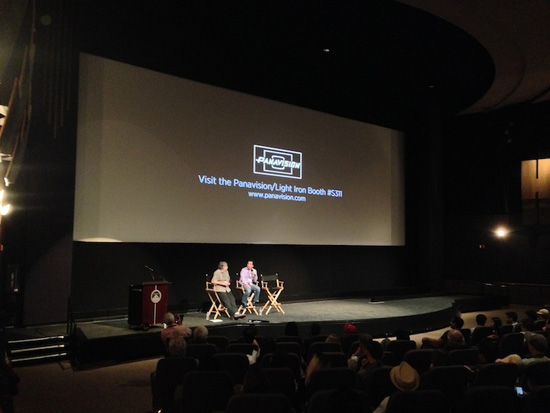 Dan
Sasaki (Panavision) and David Heuring on stage at the Paramount Theatre,
Hollywood. Image by Tyler Purcell Dan
Sasaki (Panavision) and David Heuring on stage at the Paramount Theatre,
Hollywood. Image by Tyler PurcellThe audience was eerily quiet as the first anamorphic 65mm footage was shown in public since the format disappeared in the '60s. There was gate weave and flicker, showing how uncalibrated the Paramount theater projector was, from decades of not running this format. However, everyone was in awe of what was projected, the contrast, the color, depth of field, lens coatings and flares, it was like watching an old film shot with modern stocks. The story behind this format being resurrected and how it may usher in a new era of large-format acquisition and distribution is very interesting. Robert Richardson wanted to do something different for Quentin's new film. It appeared he was tired of the same old look. Whilst at Panavision he brought up this subject and was shown some older lenses for a more distinctive look. Unfortunately, every single lens that was brought out still looked too damn good, too "modern" for Robert. As a last-ditch effort to supply Robert with something unique, out came the old Camera 65 lenses from the way back of storage. Some may recall this format coming from Cinerama when they switched from 3-panel 35mm to single 65mm. They developed a lens system which would allow them to retain the same ultra-wide aspect ratio (2.76:1 with 1.25 squeeze) of their screens and use a single negative. Although the Cinerama version was short lived, it spawned three future systems; Todd-AO, MGM Camera 65 and Ultra Panavision 70. |
More in 70mm reading: Motion pictures photographed in MGM Camera 65 / Ultra Panavision 70 The MGM PANAVISION Enlarged-film System The Hateful Eight - in 65mm?? Nolan's "Dunkirk" will feature over 100 minutes of IMAX material in70mm.com @ youtube.com "As Good as it Gets"- Demonstrates power of large format "As Good as it Gets" - Afterthoughts "As Good as it Gets" Todd-AO Test Film |
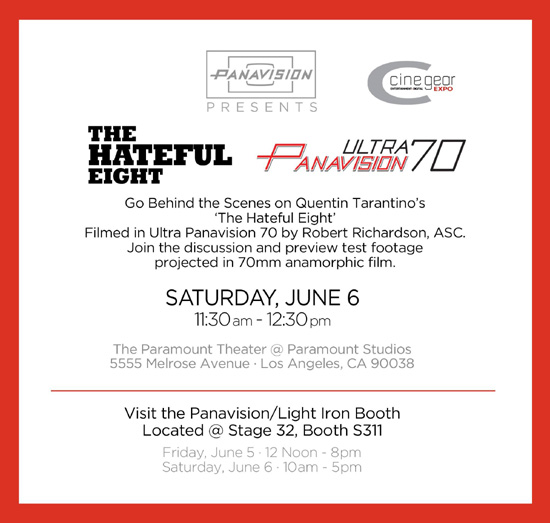 Of course, Richardson fell in love with these lenses, mostly with the
softness of the image caused by the coatings. Our modern cameras and stocks
are so good, they reveal imperfections in actors, sets and backdrops.
Creating softness has been a goal of modern cinematographers, camera
manufacturers and post production technicians. These lenses provide that
over-all softness without resorting to filtration and tweaking in post
production. Plus, the bokeh effect (out of focus distortion) is extremely
artistic, almost looking like a painting rather then simply hard edged, out
of focus areas. This can be referred to as nisen bokeh or bokeh outlining. Of course, Richardson fell in love with these lenses, mostly with the
softness of the image caused by the coatings. Our modern cameras and stocks
are so good, they reveal imperfections in actors, sets and backdrops.
Creating softness has been a goal of modern cinematographers, camera
manufacturers and post production technicians. These lenses provide that
over-all softness without resorting to filtration and tweaking in post
production. Plus, the bokeh effect (out of focus distortion) is extremely
artistic, almost looking like a painting rather then simply hard edged, out
of focus areas. This can be referred to as nisen bokeh or bokeh outlining.
The lenses had sat since the '60s and were completely frozen. Plus, the lenses were designed to be used with 65mm cameras, of which Panavision has very few. Plus, finding suitable projection lenses was another huge challenge since there were very few to begin with. However, Richardson wanted to do a test with these lenses and show it to Quentin. So Panavision went ahead and took a few select lenses and started to experiment. The first big hurdle was freezing the lenses. This was huge because back when they built them, they were using brass and aluminium with lithium grease. So the grease had oxidized and made the connection between the metal and brass like concrete. This meant the lenses had to be stripped down, but the only way of taking them apart is to get them to twist! So they tried everything and the only thing that worked was heat, lots and lots of heat. Eventually they freed the lenses up and could dismantle them. The second hurdle was the fact the elements had dots on them, typical stuff you see with glass that's been sitting for a long time. So the elements themselves needed to be re-worked with new coatings, comparable to the original. Finally, the original cameras weren't reflex, so the rear elements protruded excessively and occluded the camera mirror shutter. This proved to be a huge problem with modern reflex cameras, the glass actually touched the mirror! This forced Panavision to alter the final element and move it away from the mirror. |
|
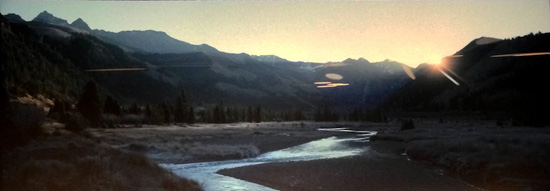 With lenses in hand, Richardson and a small team went out and shot some test
footage in similar locations to where the film was going to be shot. The day
of screening the footage was nerve-wracking for Panavision. They still
didn't have a solution for projecting and they only had a few lenses. Of
course, when Quentin saw the material, he was overwhelmed and the decision
was made right then and there, to shoot his next film;
"The Hateful Eight",
in Ultra
Panavision 70. With lenses in hand, Richardson and a small team went out and shot some test
footage in similar locations to where the film was going to be shot. The day
of screening the footage was nerve-wracking for Panavision. They still
didn't have a solution for projecting and they only had a few lenses. Of
course, when Quentin saw the material, he was overwhelmed and the decision
was made right then and there, to shoot his next film;
"The Hateful Eight",
in Ultra
Panavision 70.Panavision spent the next few weeks rebuilding a total of 19 lenses, some of them with the older prism anamorphic element. They made special filters to go along with the lenses and matte boxes to hold those filters. They made a special 2000ft magazine for the sound camera since Quentin wanted long takes and even convinced Kodak to make those longer rolls of film. The final step in the whole process was to figure out projection. The workflow for spherical 70mm projection is straightforward and has been done on many films over the last few years; "The Master", "Interstellar" and even "Inherent Vice", all projected on 70mm Spherical. So projectionists have some experience with this format, but very few people have experience with anamorphic 70mm. The call went out and an expert was hired to come in and not only develop new projection lenses but also service the 50 theaters in the US who signed up for the 70mm release of "The Hateful Eight". Some theaters will need to purchase used 70mm projectors, others will need to have their current projectors calibrated to eliminate flicker, gate weave and reduce registration issues. Schneider got the contract to make the lenses and it appeared Quentin paid for them out of either the budget for the film or his own pocket. |
|
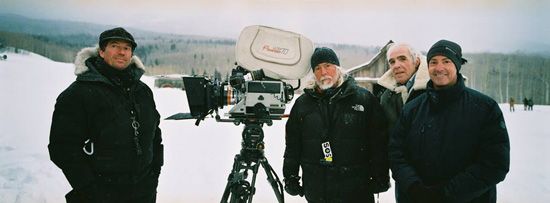 On the set of Quentin Tarantino's "The Hateful Eight",
the Panavision
System 65 camera, Robert Richardson and crew. The
last week of shooting in Telluride in Ultra Panavision 70 (ultimo March
2015). First AC Gregor Tavenner, Cinematographer Robert Richardson ASC and Panavision's Bob
Harvey & Jim Roudebush. On the set of Quentin Tarantino's "The Hateful Eight",
the Panavision
System 65 camera, Robert Richardson and crew. The
last week of shooting in Telluride in Ultra Panavision 70 (ultimo March
2015). First AC Gregor Tavenner, Cinematographer Robert Richardson ASC and Panavision's Bob
Harvey & Jim Roudebush.Outside of a few production hiccups with principal photography related to the freezing cold, the 65mm cameras performed flawlessly in negative-degree weather for the entire shoot. Sure, lens fogging was always a concern and needed to be looked after, but according to on-set reports, the camera bodies were perfect. Here in Los Angeles, the production was on freezing sound stages to mimic the location shooting so everyone had actual condensation coming from their breaths. Yet, those old film cameras, originally made for "Far and Away" in the early 90's, worked flawlessly. What Robert Richardson and Quentin Tarantino have done is successfully resurrect a film format which had long been since forgotten. In doing so, they've paved the way for future filmmakers to use this format since the workflow from production through distribution will be well established. There are already two major Hollywood movies signed up for this new format, rumors are one will be PT Anderson's new film. At the same time, Panavision has been flooded with requests for budgets and time-frames/schedules. There have been financial battles as well, studio's battling with money to just get ONE of the two sound cameras before someone else gets them. This demand has made Panavision contemplate building an all-new 65mm cameras and they may do so if these films wind up being good money for them. They're also adapting the new Arri Alexa 65 to work with the new anamorphic glass and there is already a movie signed up to shoot with that combination. Rumors are that 35mm and digital releases of "The Hateful Eight" will be standard 2.35 anamorphic with black bars at the top and bottom. |
|
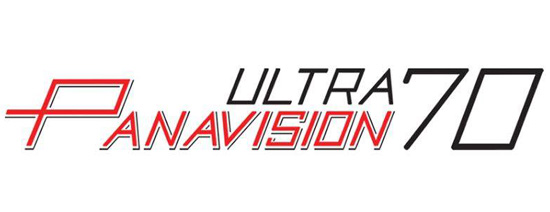 After seeing the test footage, there was a rousing applause. It's apparent
the audience was stunned by what we had just seen. However, it wasn't over
yet. The next thing we saw was a DCP version of the material and it really
shows how proper film projection truly trumps digital. The blacks were mushy
and undefined, the highlights were clearly peaking and the whole image
looked flat. All of that beautiful depth seen in the film projection was
lost. We sadly realized this format, developed in the 50's, is still better
then all the money we've thrown at conventional digital projection. Sure,
laser projection is one step further, but currently only 4K. Standard 5 perf,
65mm negative is 8K, and when you strike prints off the negative, you still
have a lot more resolution then the absolute best digital cinema projection
today. Quentin's goal is to produce all 50 prints from the negative, and
deliver an amazing cinematic experience, and bring people back to the theater. December 25th 2015 is the release date for "The Hateful Eight"
in 70mm and 35mm only. Those theaters willing to screen on film, will get a
head start as digital release is slated for two weeks later. After seeing the test footage, there was a rousing applause. It's apparent
the audience was stunned by what we had just seen. However, it wasn't over
yet. The next thing we saw was a DCP version of the material and it really
shows how proper film projection truly trumps digital. The blacks were mushy
and undefined, the highlights were clearly peaking and the whole image
looked flat. All of that beautiful depth seen in the film projection was
lost. We sadly realized this format, developed in the 50's, is still better
then all the money we've thrown at conventional digital projection. Sure,
laser projection is one step further, but currently only 4K. Standard 5 perf,
65mm negative is 8K, and when you strike prints off the negative, you still
have a lot more resolution then the absolute best digital cinema projection
today. Quentin's goal is to produce all 50 prints from the negative, and
deliver an amazing cinematic experience, and bring people back to the theater. December 25th 2015 is the release date for "The Hateful Eight"
in 70mm and 35mm only. Those theaters willing to screen on film, will get a
head start as digital release is slated for two weeks later. |
|
| Go: back - top - back issues - news index Updated 22-01-25 |
